High-net-worth investors (HNWIs) typically have liquid financial assets (e.g., cash on hand or an asset that can be readily converted to cash) of between $1 million and $5 million. And ultra-HNWIs have more than $25 million in liquid assets. These groups are highly desirable clients, especially if your firm is in growth mode. Acquiring an HNWI or ultra-HNWI could put you well down the path to reaching your goals for the year. But how do you go about prospecting for high-net-worth clients?
Of course, all clients have different wants, needs, and goals for their money and their future, but the amount of wealth they hold can be a big influence on what they value most from a financial advisor—and what you need to do to attract and retain them. Below I’ll discuss the unique wants and needs of highly affluent clients and lay out the key strategies that will help you go out and get them.
What HNWIs Want
According to a blog post from The Advisor Coach, citing research from the Spectrem Group, a majority of ultra-HNWIs (63 percent) are retired, and another 14 percent are semiretired. Nearly 30 percent are considered “event-driven investors,” meaning they work with advisors when they have a specific need, such as retirement planning.
Therefore, it shouldn’t come as a surprise that estate planning assistance and customized wealth management solutions are among the primary needs of highly affluent clients. This group gets involved in philanthropy, too, so assisting them in identifying charitable giving solutions and minimizing tax liabilities could attract them to your firm. Other attractive strategies are facilitating discussions about the use of family wealth, teaching children financial skills, and providing knowledge and products that involve impact investing.
4 Steps to Get Started
What does the acquisition process involve? How do you start prospecting for high-net-worth clients? Here are four essential steps:
1) Identify potential clients. Referrals, an important part of any advisor’s growth strategy, may play an even greater role in acquiring HNWIs. Look for help from your existing client base and other strategic partnerships and centers of influence (COIs), such as attorneys and CPAs. Commonwealth advisor Adam Spiegelman, CFP®, of Spiegelman Wealth Management in Lafayette, California, says:
The best way by far to gain introductions to new potential clients is to ask existing clients that you like and trust if they know anyone who could potentially benefit from working with your firm.

FREE DOWNLOAD
Advanced Financial Planning Strategies
for High-Net-Worth Clients
Explore creative, comprehensive financial planning solutions—from asset protection to
charitable giving—for your high-net-worth clients’ unique needs.
2) Position your value-add. Once you get referrals, tell them a good story. Why should they work with you? What makes you different? Certainly, you’ll want to address how you service the relationship. Commonwealth advisor Gail Simons, CFP®, of The Highbridge Financial Group in Tarrytown, New York, shares why she got into the field and what she hopes to help her clients accomplish. She also asks this pointed question:
If I could wave my magic wand and be everything you’re looking for in a financial advisor, what would that be?
An empathetic, holistic approach to wealth management may resonate well with HNWIs. For Spiegelman, this means responding to client inquiries or requests within a few hours. His firm has chosen to take on only six to eight new clients each year to maintain a staff-to-client ratio that’s low enough to allow them to provide such personalized service.
Simons likewise works to establish herself as the “go-to person” and “an indispensable source of advice.” Advisors likely know more about their clients than most anyone but the clients’ doctors, so it’s vital to create that kind of rapport.
3) Prepare potential solutions. Be prepared to speak about the wealth management partners and experts you have access to. Simons often deals with needs for complex estate planning and tax-driven investment strategies. Spiegelman frequently refers his clients to estate planners, CPAs, life coaches, mortgage brokers, and contractors. Other unique planning questions arise around business transitions and how to be fair and equitable to clients’ heirs.
Commonwealth advisors know they can reach out to our experts when necessary. Simons frequently leverages Commonwealth’s Investment Consulting Services team for a second opinion. The Advanced Planning and Insurance and Annuities teams are lifelines as well. Simons reassures her clients by saying, “If I don’t have the answer, I do know how to get it!”
To help scale his practice, Spiegelman delegates where he can—he uses Commonwealth’s Custom Trading Services and model portfolios to manage investments. He relies on analysts from our Investment Management and Research team to provide product knowledge on private equity and nontraded REITs and our advanced planning consultants for solutions to concentrated single-stock positions.
4) Negotiate the deal. Spiegelman and Simons both have found that HNWIs seem to be more value sensitive than price sensitive, though, according to Spiegelman, they can be “super sensitive to small fees.” That’s why he tends to pick up transaction and wire/trading fees. A study by Price Metrix backs this up. It found that advisors who priced their services between 75 basis points and 100 basis points of invested assets had the same production from HNWIs as those who priced their business between 50 basis points and 75 basis points.
As you might expect, the similarities end there. Simons charges a combination of planning and AUM fees, explaining to clients that “a fee is only an expense in the absence of value.” Spiegelman finds it simpler to wrap everything under an AUM fee.
Keeping HNWIs Satisfied
As with most client relationships, communication is critical to retaining HNWIs. They need to know that you are regularly monitoring their finances and are ready to act when necessary. Showing you care on a personal level—by recognizing anniversaries, birthdays, and other special events—also matters. “I call clients—especially HNW clients—at least four to six times per year,” says Simons. “I also send out communications Commonwealth provides when I find them timely and relevant.”
The same goes for Spiegelman, who calls clients regularly and meets face to face at least once per year. He sends out a weekly newsletter, invites clients to lunch or dinner, and hosts an open house from time to time. He gets creative when recognizing special events:
I sent a beer bottle opener with a recycled wood backing that had the OSU Beavers logo on it to a client’s son who had just graduated from college. This gift prompted a call from the parents, which ultimately lead to a productive financial planning discussion.
In the end, though, being up front and direct with all clients is the best approach. Transparency will help improve your clients’ confidence and trust in you.
A Strategy for Any Client
You may fall short in your goals for prospecting for high-net-worth clients, but you know what? It probably won’t matter—because the same strategies you use to attract HNWIs to your business are the same strategies that will appeal to less affluent investors who can also bring tremendous value and growth to your firm.


